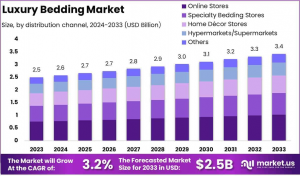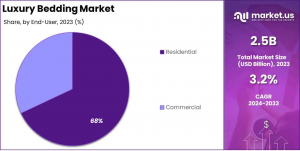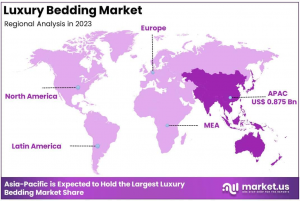Luxury Bedding Market is projected to reach USD 3.4 Billion by 2033, growing at a 3.2% CAGR from 2024 to 2033.
Asia Pacific dominates the global luxury bedding market with a 35% share, valued at USD 0.875 billion in 2023. Get up to 30% off—Buy Now!”
NEW YORK, NY, UNITED STATES, January 27, 2025 /EINPresswire.com/ -- **Report Overview**— Tajammul Pangarkar
The Global Luxury Bedding Market is projected to reach approximately USD 3.4 billion by 2033, up from USD 2.5 billion in 2023, growing at a CAGR of 3.2% from 2024 to 2033.
Luxury bedding refers to high-end, premium-quality bedding products that offer superior comfort, aesthetic appeal, and durability. These products typically include luxury mattresses, pillows, sheets, comforters, duvet covers, and blankets, often crafted from the finest materials like Egyptian cotton, silk, or high-thread-count linens. They are designed not only to enhance sleep quality but also to elevate the overall bedroom experience with a focus on both functionality and opulence.
The luxury bedding market is a segment within the broader home textiles industry that caters to consumers seeking exclusive, high-quality bedding solutions. This market is characterized by a growing demand for products that combine superior craftsmanship, innovative design, and sustainable materials. As disposable incomes rise, particularly in emerging economies, there is an increasing shift toward luxury products that promote wellness, comfort, and aesthetic appeal. Consumers are becoming more discerning, with a preference for brands that offer customization, sustainable production practices, and cutting-edge designs.
Request Your Sample Report Today for In-Depth Insights and Analysis at https://market.us/report/luxury-bedding-market/request-sample/
Key growth factors driving the luxury bedding market include an increasing emphasis on personal well-being, rising interest in home decor, and growing awareness about the benefits of high-quality sleep. The demand is also fueled by the expansion of e-commerce platforms, which have made luxury bedding more accessible to a broader audience. Furthermore, the evolving trend of sustainable luxury presents an opportunity for companies to innovate with eco-friendly materials and production methods. With changing consumer lifestyles and preferences, there is ample opportunity for market players to expand their product offerings and capture a larger share of this dynamic and competitive segment.
**Key Takeaways**
~~ The luxury bedding market is expected to grow from USD 2.5 billion in 2023 to USD 3.4 billion by 2033, reflecting a 3.2% CAGR.
~~ Bed Linen leads the market, holding over 41% of the market share, driven by high demand for premium materials and sleep-enhancing qualities.
~~ Online stores dominate with over 30% of the market share, fueled by convenience and effective digital marketing strategies.
~~ The residential sector leads with more than 68% of market share, driven by growing investments in home aesthetics and wellness.
~~ Asia-Pacific leads regionally, accounting for 35% of the market share, supported by rising disposable incomes and an expanding middle class prioritizing quality sleep.
**Market Segmentation**
In 2023, bed linen led the luxury bedding market with over 41% market share, driven by consumer demand for premium materials like Egyptian cotton, silk, and linen, along with growing awareness of the health benefits of quality sleep. Other key segments include blankets & quilts, valued for their warmth and style, especially in colder climates, and down covers, which are popular for their warmth, softness, and breathability. Duvets, prized for their versatility and luxury materials like down and silk, also saw steady growth. Mattresses, especially those offering specialized support like memory foam and latex, have surged due to increased focus on wellness and sleep health. Additionally, luxury pillowcases & shams are gaining attention for their aesthetic appeal and comfort, while protectors are increasingly popular for hygiene and product longevity. Smaller but notable is the "others" segment, which includes niche items like bed skirts and decorative cushions, catering to personalized, high-end home décor needs.
In 2023, online stores dominated the luxury bedding market with over 30% share, driven by the convenience, variety, and competitive pricing offered by e-commerce platforms. Specialty bedding stores remain significant, offering personalized service and hands-on experiences, especially in urban areas. Home decor stores also play a key role, providing a cohesive shopping experience for consumers seeking integrated bedding and home furnishings. While hypermarkets and supermarkets have a smaller share, they still contribute by offering select premium bedding at competitive prices. The "others" segment, including exclusive boutiques and direct sales through luxury hotels, caters to affluent consumers seeking personalized and unique bedding collections, playing a crucial role in brand visibility and loyalty.
In 2023, the residential sector led the luxury bedding market with over 68% share, driven by a growing focus on home aesthetics, comfort, and wellness, as well as the rise of remote work and higher disposable incomes. Consumers are increasingly investing in premium bedding for enhanced sleep quality and a luxurious lifestyle. The commercial sector, which includes luxury hotels and resorts, also plays a significant role, with these businesses prioritizing high-quality bedding to improve guest comfort and brand reputation. While smaller than the residential sector, the commercial segment is expected to grow steadily as luxury travel rebounds.
**Key Market Segments**
By Product Type
~~Blankets & Quilts
~~Bed Linen
~~Down Covers
~~Duvets
~~Mattresses
~~Pillowcases & Shams
~~Protectors
~~Others
By Distribution Channel
~~Online Stores
~~Specialty Bedding Stores
~~Home Decor Stores
~~Hypermarkets/Supermarkets
~~Others
By End-User
~~Residential
~~Commercial
**Driving factors**
Rising Disposable Income and Increasing Affluent Consumer Base
The global luxury bedding market is significantly driven by the rising disposable income across emerging markets, coupled with an increasing number of affluent consumers. As economies in regions like Asia Pacific, particularly in countries like China and India, continue to grow, the purchasing power of consumers has greatly increased. This upward trend in disposable income has made luxury bedding more accessible to a broader demographic, expanding the market’s potential. Affluent consumers are increasingly inclined to invest in high-end home products that offer both comfort and status, with luxury bedding standing out as a key category.
"Order the Complete Report Today to Receive Up to 30% Off at https://market.us/purchase-report/?report_id=18210
**Restraining Factors**
High Cost and Limited Market Accessibility
One of the major restraints to the global luxury bedding market’s growth is the high cost of premium bedding products. Luxury bedding items, made from superior fabrics and advanced manufacturing techniques, come with a steep price tag that limits their accessibility to a niche group of consumers. While affluent buyers are more likely to invest in these luxury products, the vast majority of the population finds such pricing prohibitive. This creates a barrier to mass-market penetration, as only a small percentage of consumers can afford luxury bedding on a consistent basis.
**Growth Opportunity**
Growing Focus on Sustainable and Eco-Friendly Luxury Bedding
Sustainability has emerged as a key opportunity for the global luxury bedding market, as increasingly eco-conscious consumers seek environmentally friendly products. There is a rising demand for bedding made from organic or eco-friendly materials such as organic cotton, bamboo, and linen, which are seen as both luxurious and sustainable. Consumers are becoming more aware of the environmental impact of their purchasing decisions and are willing to pay a premium for products that align with their values. This shift toward sustainability presents a significant opportunity for brands in the luxury bedding segment to differentiate themselves in a crowded market.
**Latest Trends**
Increasing Demand for Personalized and Custom Bedding Solutions
In recent years, there has been a marked trend towards personalization in the luxury bedding market, with consumers increasingly seeking products tailored to their specific preferences. Customization options—such as monogrammed sheets, bespoke mattress covers, or unique fabric selections—allow consumers to create a more individualized sleeping experience. This trend is particularly strong among affluent buyers who view their homes as reflections of their personal style and identity. Custom bedding also provides an opportunity for brands to cater to the evolving tastes and preferences of high-net-worth individuals who demand exclusivity in all aspects of their lives.
**Regional Analysis**
Asia Pacific Luxury Bedding Market with Largest Market Share of 35% in 2023
In 2023, the Asia Pacific region leads the global luxury bedding market, capturing 35% of the total share, valued at USD 0.875 billion. This growth is driven by a rising middle class, higher disposable incomes, and increasing demand for premium, sustainable bedding products in countries like China, India, and Japan.
North America follows closely, particularly the U.S., where consumer demand for luxury bedding is fueled by trends in home renovation and wellness. Europe also remains a key player, with strong demand in countries like the UK and Germany, driven by a preference for high-quality and eco-friendly bedding options.
The Middle East & Africa (MEA) and Latin America show steady growth, with affluent consumers in the UAE, Saudi Arabia, Brazil, and Mexico increasingly investing in luxury bedding. However, Asia Pacific remains the dominant region, with the largest market share in 2023.
!! Request Your Sample PDF to Explore the Report Format !!
**Key Players Analysis**
The Global Luxury Bedding Market in 2024 is expected to see significant competition among key players, each leveraging distinct strategies to capture market share. Pacific Coast and Hollander are likely to maintain strong presences with their emphasis on high-quality down and feather bedding, catering to the demand for premium comfort. Sferra and Frette continue to position themselves as high-end, heritage brands, with an established reputation for luxury linens. The White Company and Ralph Lauren Home capitalize on brand prestige, combining sophisticated designs with upscale fabrics.
Boll & Branch and Matouk are benefiting from a growing trend toward eco-conscious luxury, offering sustainably sourced bedding. Brooklinen (Luxe Collection) and Parachute Home represent the younger, direct-to-consumer brands, with a focus on quality and affordability without sacrificing luxury appeal. Peacock Alley remains a key player, offering premium handcrafted bedding for discerning consumers. With increasing demand for luxury, these brands are expected to drive innovation, focusing on both sustainability and personalization to stay competitive.
Top Key Players in the Market
~~ Pacific Coast
~~ Hollander
~~ Sferra
~~ Frette
~~ The White Company
~~ Ralph Lauren Home
~~ Boll & Branch
~~ Matouk
~~ Brooklinen (Luxe Collection)
~~ Anichini
~~ Parachute Home
~~ Peacock Alley
~~ Other Key Players
**Recent Developments**
~~ In 2024, Tempur Sealy International, Inc.: Announced the pricing of a $1.6 billion senior secured Term Loan B facility, with a seven-year term and SOFR + 250 bps, set to close in the coming weeks.
~~ In 2024, Serta Simmons Bedding (SSB): Launched the new Beautyrest Black® Collection and reintroduced its iconic Beautyrest® campaign with a modern twist on the classic bowling ball ad.
~~ In 2023, Saatva: Merged with Bedding Industries of America, enhancing operations with a vertically integrated supply chain to support the Eclipse and Eastman House brands and retail partners.
**Conclusion**
The global luxury bedding market is projected to grow from USD 2.5 billion in 2023 to USD 3.4 billion by 2033, at a CAGR of 3.2%. Key drivers include rising disposable incomes, growing demand for premium and sustainable products, and an increasing focus on wellness and home aesthetics. Bed linen, mattresses, and blankets lead the market, while online stores dominate as the primary distribution channel. The Asia Pacific region, particularly China, India, and Japan, holds the largest market share. Despite challenges like high costs and limited accessibility, the market offers significant opportunities in sustainable luxury and personalized bedding solutions, with top players innovating to meet evolving consumer preferences.
Discover Further Reports that are Related to this Topic.
Luxury Skincare Market - https://market.us/report/luxury-skincare-market/
Luxury Resale Market- https://market.us/report/luxury-resale-market/
Luxury Concierge Service Market- https://market.us/report/luxury-concierge-service-market/
Luxury Handbag Market - https://market.us/report/luxury-handbag-market/
Luxury Products for Kids Market- https://market.us/report/luxury-products-for-kids-market/
Luxury Car Rental Market- https://market.us/report/luxury-car-rental-market/
Luxury Furniture Market - https://market.us/report/luxury-furniture-market/
Smart Pillow Market- https://market.us/report/smart-pillow-market/
Luxury Goods Market - https://market.us/report/luxury-goods-market/
Luxury Hotel Market- https://market.us/report/luxury-hotel-market/
Lawrence John
Prudour
+91 91308 55334
email us here
Visit us on social media:
Facebook
LinkedIn
Legal Disclaimer:
EIN Presswire provides this news content "as is" without warranty of any kind. We do not accept any responsibility or liability for the accuracy, content, images, videos, licenses, completeness, legality, or reliability of the information contained in this article. If you have any complaints or copyright issues related to this article, kindly contact the author above.




